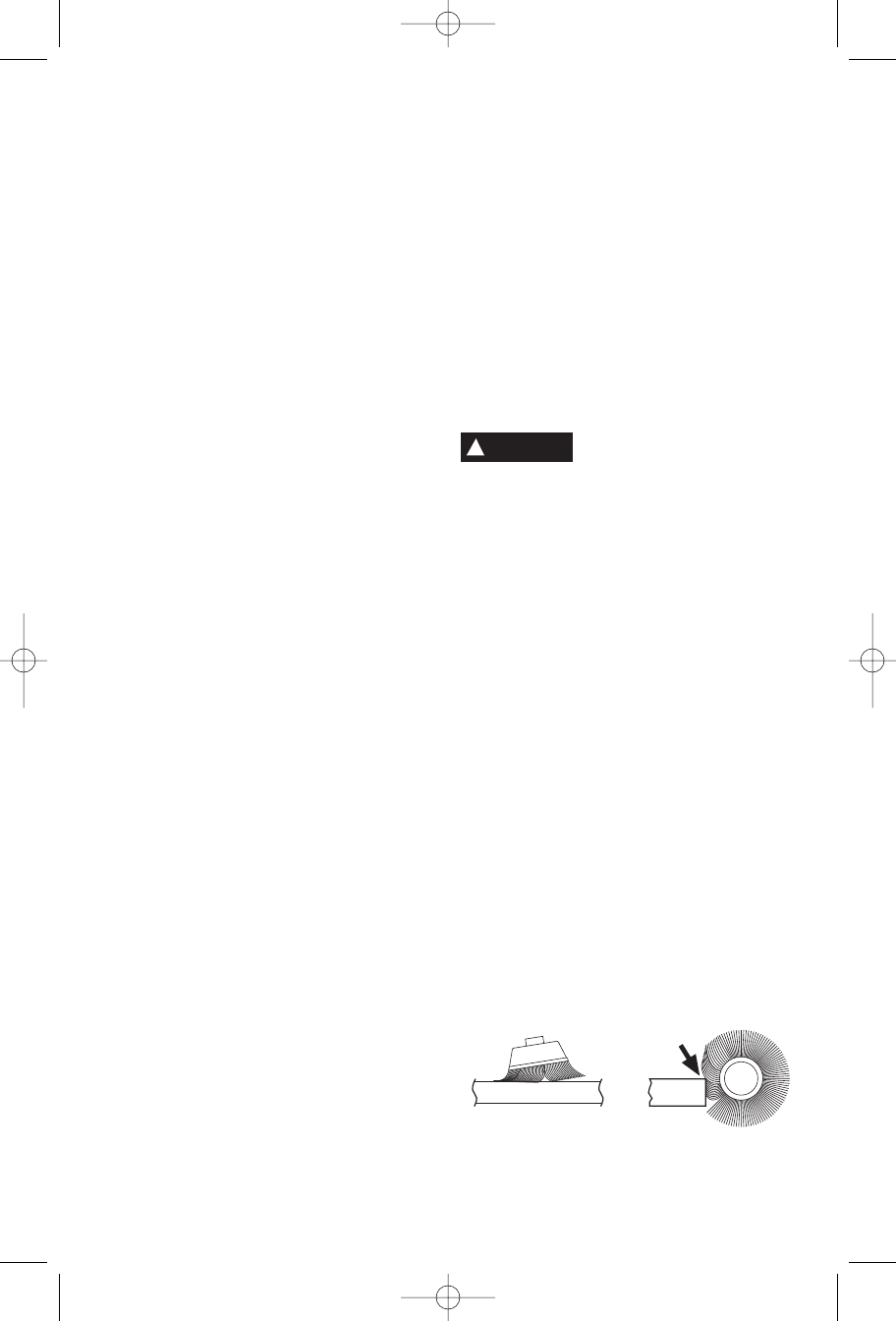
-8-
You will extend the life of your bits and do
neater work if you always put the bit in contact
with the work before pulling the trigger. During
the operation, hold the tool firmly and exert
light, steady pressure. Too much pressure at
low speed will stall the tool. Too little pressure
will keep the bit from cutting and cause excess
friction by sliding over the surface. This can be
damaging to both tool and bit.
DRILLING WITH VARIABLE SPEED
The trigger controlled variable speed feature
will eliminate the need for center punches in
hard materials. The variable speed trigger
allows you to slowly increase RPM. By using a
slow starting speed, you are able to keep the
bit from “wandering”. You can increase the
speed as the bit “bites” into the work by
squeezing the trigger.
DRILL BITS
Always inspect drill bits for excessive wear.
Use only bits that are sharp and in good
condition.
TWIST BITS: Available with straight and
reduced shanks for wood and light duty metal
drilling. High speed bits cut faster and last
longer on hard materials.
CARBIDE TIPPED BITS: Used for drilling
stone, concrete, plaster, cement and other
unusually hard nonmetals. Use continuous
heavy feed pressure when employing carbide
tip bits.
DRILLING WOOD
Be certain workpiece is clamped or anchored
firmly. Always apply pressure in a straight line
with the drill bit. Maintain enough pressure to
keep the drill “biting”.
When drilling holes in wood, twist bits can be
used. Twist bits may overheat unless pulled
out frequently to clear chips from flutes.
Use a “back-up” block of wood for work that is
likely to splinter, such as thin materials.
You will drill a cleaner hole if you ease up on
the pressure just before the bit breaks through
the wood. Then complete the hole from the
back side.
DRILLING METAL
There are two rules for drilling hard materials.
First, the harder the material, the greater the
pressure you need to apply to the tool.
Second, the harder the material, the slower the
speed. Here are a couple of tips for drilling in
metal. Lubricate the tip of the bit occasionally
with cutting oil except when drilling soft metals
such as aluminum, copper or cast iron. If the
hole to be drilled is fairly large, drill a smaller
hole first, then enlarge to the required size, it’s
often faster in the long run. Maintain enough
pressure to assure that the bit does not just
spin in the hole. This will dull the bit and greatly
shorten its life.
DRILLING MASONRY
Use carbide-tipped masonry bit for cinder
block, mortar, common brick, soft stone and
other materials. The amount of pressure to be
used is dependent upon the type of material
being drilled. Soft materials require less
pressure while the hard materials need more
pressure to prevent the drill bit from spinning.
Before using an accessory,
be certain that its maximum
safe operating speed is not exceeded by the
nameplate speed of the tool. Do not exceed
the recommended wheel diameter.
SANDING AND POLISHING
You will find the “Lock-ON” button feature a
convenience for the continuous operation
required for rough sanding. Fine sanding and
polishing require “touch”. Select the most
efficient speed.
When using polishing bonnets, alway be sure
the excess string that secures the bonnet is
tucked well within the bonnet during operation.
WIRE BRUSHES
Work with brushes requires high speeds. Use
of the “Lock-ON” button feature will provide a
much easier operation.
BRUSHING PRESSURE
1. Remember, the tips of a wire brush do the
work. Operate the brush with the lightest
pressure so only the tips of the wire come in
contact with the work.
2. If heavier pressures are used, the wires will
be overstressed, resulting in a wiping action;
and if this is continued, the life of the brush will
be shortened due to wire fatigue.
3. Apply the brush to the work in such a way
that as much of the brush face as possible is in
Operating Tips
!
WARNING
INCORRECT: Excessive pressure can cause wire breakage.
SM 2610956854 09-08 9/18/08 2:51 PM Page 8


















